Wet Basement Walls: Causes & Solutions
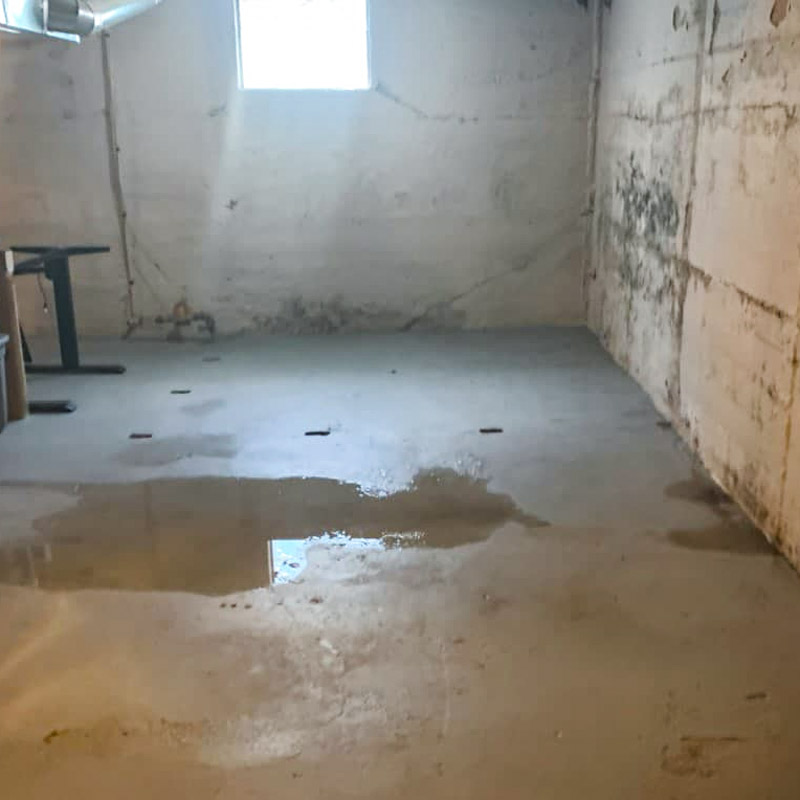
Unless you’ve installed one of those fancy cascading wall fountains, every wall of your home should be dry. This rule extends to your basement walls, too — just because the basement is partially below ground is no excuse for damp walls.
Having a damp or wet basement is a source of frustration. Anything you store in that space will smell, degrade, and even develop biological growth like mold or mildew. Ongoing water intrusion will also lead to foundation cracks and damage.
Acculevel understands the significance of a healthy home foundation, and how essential healthy air quality is to the safety of you and your family. We’ve been waterproofing homes and repairing foundations since our start in 1996. We’re a family-owned and operated company that serves Indiana and portions of the surrounding states.
In this article, we’re going to discuss what the best solution is for your wet basement walls. The best solution for you depends on a number of factors: the source of the water intrusion, the type of foundation you have, and even your future plans. These repairs could include foundation repairs, waterproofing, or even encapsulation. We’ll explore these variables, what impact they have, and recommend the best solution(s).
How Is Water Getting Into Your Basement?
The first step is determining how — and where — the water is entering your home. The answer may be obvious to you if you have a significant crack in your foundation and the water is actively collecting in that area.
But if there’s no visible source of water, you could be understandably confused. The water may just appear on the walls, on the floor, or even at the cove joint — where the wall and floor meet.
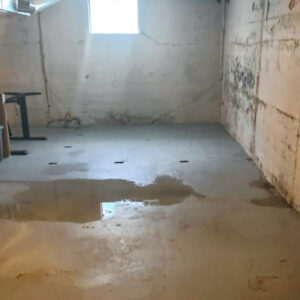
This photo was taken by an Acculevel project advisor during a free home evaluation. Water is seeping in at the cove joint, causing puddles to form in the basement.
The real source of your wet basement problem could be coming from the ground outside your foundation walls. How much rain have you had recently? Do you live in an area that floods easily, or near a body of water like a creek or pond?
If the ground outside your home is saturated with water, hydrostatic pressure develops. This is a term for what happens when the soil has absorbed all the moisture it can. The ground swells as water accumulates, and excess water exerts pressure against anything in its path — including your home.
Since your foundation is built from organic materials (brick, concrete, mortar), water can seep into and through your basement walls. Concrete walls are porous materials, meaning there are tiny openings that allow water to squeeze through. This is how it’s possible for you to have water in your basement with no easily identifiable source.
As hydrostatic pressure “pushes” against your foundation, it can cause foundation cracks and damage.
Are There Cracks Forming in Your Basement Wall?
Small cracks, often called hairline cracks because of their thin width, should be repaired promptly. This holds true even if those hairline cracks don’t appear to be leaking yet.
Once a crack forms, it’s not going to go away. It can be repaired, and often these repairs are good for many years. Many homeowners put off repairing simple cracks, but you must remember that crack repairs don’t just prevent water intrusion, they also hold the foundation together to maintain stability.
There are several different repair methods for repairing cracks in your foundation, but Acculevel prefers an epoxy fill method. Over the last 20+ years, we’ve tried a variety of repair options, but epoxy is the only one that meets all of our requirements. It sets quickly, provides a long-lasting seal, and is still flexible enough to move with the seasonal expansions and contractions of your foundation. We warranty this type of crack repair for 5 years.
Wall Cracks Become Foundation Damage
Larger cracks create more trouble for your home than basement wall leaks. These breaks in the foundation are a sign of significant damage. In the photo below, you can see two different types of cracks have formed.
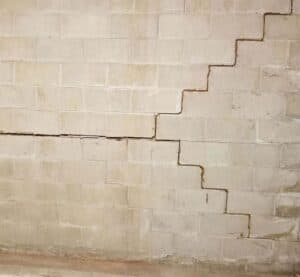
This photo was taken by an Acculevel project advisor during a free in-home assessment.
Long horizontal cracks can be found in any type of foundation wall, whether it’s constructed with poured concrete, brick, or cinder block. The zig-zag or stair-step type of crack only happens in brick or block, because the wall splits along the mortar lines.
Both kinds of cracks indicate that the wall is starting to bow inward, or buckle. You do not want to postpone this type of repair. The worse it gets, the more invasive and expensive it will be to repair. If the wall is bowing less than 2 inches, it can be repaired with carbon fiber straps which don’t require yard excavation. If it’s moving more than 2 inches, you’ll need more invasive and costly repairs, like wall anchors or tiebacks.
You can learn more about bowing walls and repair methods in this article.
Once you’ve had cracks in the basement walls repaired, it’s time to address the water in the basement.
You Need A Drainage System if You Have Water Intrusion
Water may be an inanimate object, but it acts like a creature of habit. Once water has created a path into your home, it will keep coming back to that same weakened area. Eventually, it will re-open the original crack(s) or create new ones that connect to the original gaps.
Either way, the end result is the same: once you see water seepage, it’s just a matter of time before you’ll need basement waterproofing.
A Waterproofing System Has Two Major Components
The goal of all waterproofing solutions is to manage and remove water from your home. It doesn’t keep water from coming in, it collects water that enters. If you’re looking for a solution that will keep everything in your basement dry, what you want is encapsulation (we’ll cover that, next!).
The first component is a type of drain tile that should be installed around the perimeter. A shallow trench is created in the basement floor, and a drainage track is placed on, or next to, your foundation’s footing. This channel collects the water that comes through your foundation walls or floor. Acculevel installs two different types of drainage, depending on the size and condition of your home’s footer.
As the water collects, it gets directed to the second component, the sump pump. This is installed in a “pit” which is set into the basement floor. Once the water level reaches a certain threshold, the sump pump expels the water back outside through a discharge line.
To prevent the water from circulating right back into the soil, and into your home, we run that discharge line a reasonable distance from your home’s foundation.
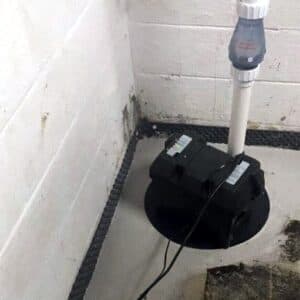
This photo was taken by an Acculevel crew member, after installing basement waterproofing. The sump pump is housed in the pit, with the drainage line running up and out of the house.
In the photo above, you can also see that the concrete floor has been re-poured, covering the interior drainage. Acculevel guarantees their basement waterproofing for the life of your structure; the sump pump comes with a battery back-up and a 5-year manufacturer warranty.
Three Reasons You Want Encapsulation
As we discussed earlier, interior drainage doesn’t keep moisture out of your home. However, encapsulation is how you “waterproof” basement walls. (We warranty our encapsulation installation for 25 years.)
What Is Encapsulation?
Many homeowners are more familiar with encapsulation as a crawl space repair. But the concept is similar; a strong inorganic material is used to cover the basement walls from top to bottom. This liner keeps all water intrusion between it and the basement wall, whether it’s caused by heavy rain or hydrostatic pressure.
This keeps the moisture from getting into the open air of your home, and forces it to go in the direction you want: down to your water drainage. This is particularly helpful if you are interested in a finished basement, which is the first reason homeowners ask about encapsulation.
You Want More Living Space
Many homeowners start out only using their basement for storage, or as a laundry room. Over time, you may want more than that but don’t want to move or build onto your home.
Many people use a portion of their basement to create a furnished living area like a family room, home office, or additional bedroom. In this case, encapsulating your basement with a waterproof barrier is a critical first step.
The barrier prevents water and moisture from coming into contact with the insulation, drywall, carpeting, etc. This is necessary to avoid mold growth, wood rot, and mildew from forming on your wall structure and furnishings.
Your Foundation Is Not Made of Concrete
If your basement is made of brick or stone, encapsulation is a serious option you need to consider. This is because brick, stone, and the mortar that holds them together are softer materials, making them more porous than concrete.
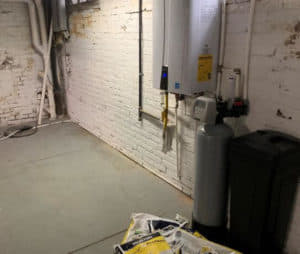
Before: this photo was taken by an Acculevel project advisor, during a free in-home assessment. The homeowner complained about frequent water intrusion and musty odors.
Even if you install an excellent water drainage system, brick and stone basements have damp walls. The increased humidity often leads to biological growth and puts an added strain on your HVAC equipment. People have argued about which is worse: heat or humidity. We’ll leave that argument to others, but we will acknowledge that humid air is harder to cool — making your air conditioner work harder (and increasing your utility costs).
Another drawback to damp air is that it’s not good for struggling or developing lungs, which leads to the third major reason you would install a waterproof barrier in your basement.

After: this photo was taken by an Acculevel crew member after water drainage and encapsulation were installed.
Your Indoor Air Quality is Compromised
Wet basements produce an environment that encourages the growth of allergens and other unwanted organisms. Mold, mildew, bacteria, viruses, and fungi can be irritating even to someone in perfect health.
But if you or someone in your family has severe allergies, asthma, or other chronic respiratory illnesses, they can be seriously damaging. This is also true of the elderly or infants, who have weakened (or still developing) immune systems.
Moisture can also become a problem for the wooden components that exist within your basement, like the floor joists and beams that hold up your wooden flooring structure. Termites are particularly fond of damp wood, because it’s easy for them to chew up and tunnel through.
A moist environment supports more than just mold- it also allows for organisms like bacteria and viruses to grow.

This chart demonstrates the findings of a study performed by ASHRAE (American Society of Heating, Refrigerating and Air-Conditioning Engineers)
You can see in the graphic above that the ideal humidity level in your home is 50%. This is when the fewest contaminants can survive. The easiest way you can ensure healthy air for you and your family is with an encapsulated basement and a whole-home dehumidifier.
This is especially important if someone in your household has a severe mold allergy or a compromised immune system.
Ready to Waterproof Your Basement?
We recommend that you find a reputable, high-quality contractor in your area. Verify that they are insured and accredited by the Better Business Bureau, and check their reviews on Google, Facebook, Angi’s List, etc.
If you live in Indiana or the surrounding areas, contact Acculevel. Our project advisors perform free in-home inspections and will work with you to address your concerns and preferred outcomes. It’s our goal to provide whole-home solutions that help you maintain your home in its optimal condition for years to come.
Ready to get your wet basement walls under control? Get in touch with the Acculevel team today to start your project consultation.
Additional Resources to Help You with Your Home Repairs
Please feel free to use our guide, Questions to Ask A Contractor, as a checklist for the topics to cover before signing an agreement with anyone.
We also have an in-depth guide to basement waterproofing that serves as an educational resource for homeowners. We encourage you to bookmark it for future reference, read the entire guide, or go directly to the section that interests you.